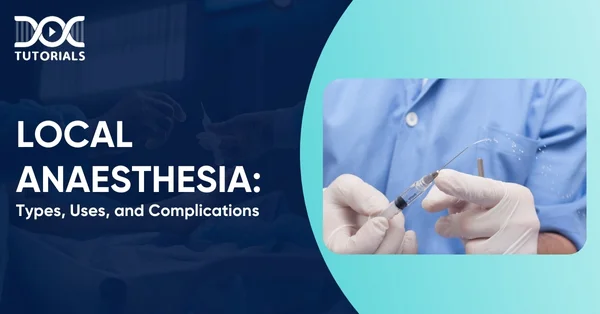Local Anaesthesia | Types, Uses, and Complications

Local anaesthesia is used to temporarily block pain in a specific part of the body. It is utilised primarily by physicians prior to minor medical surgery, such as dental surgery, skin biopsy, or suture of lacerations. There are various types of local anaesthetics, and they serve various medical purposes.
Side effects are negligible in the majority of cases, and complications rarely occur. Understanding the action of local anaesthesia, the various anaesthesia types it comes in, and its dangers will help ensure safe and effective care.
Additionally, as a NEET PG student, you need to understand this topic for exams, and for developing pharmacological expertise and delivering proper patient care. Read on to find out more!
What is Local Anaesthesia?
Local anaesthesia numbs the nerves in a body area, preventing them from transmitting pain messages to the brain. Due to its short-term action, medical professionals tend to use it for simple outpatient procedures. The anaesthetic is administered at the site where the procedure will be performed by physicians or anaesthetists.
In other instances, the patients are given sedatives to assist in lowering tension and making them relaxed. Sedation and anaesthesia combined help doctors perform procedures more comfortably without making the patient tense or uncomfortable.
Where procedures are more complex or take more time, general or regional anaesthesia is generally used in place of local anaesthesia.
What are the Types of Local Anaesthesia?
Local anaesthetic drugs are administered in 3 primary ways:
- Local Use: Anaesthetics are applied directly on the skin or mucous membranes. For example, ointments containing anaesthetics are applied to open wounds or ulcers in the mouth. Drops of anaesthetics are applied to render the eye insensitive, enabling doctors to remove particles or eyelashes.
- Local Injection: The physician injects the anaesthetic into the subcutaneous tissue or into tissues in deeper planes. This local anaesthesia prohibits pain of puncture with a needle through the skin during surgeries such as wound closure or CSF (cerebrospinal fluid) removal via spinal tap.
- Nerve Blocks: An anaesthetic drug is administered close to a nerve so as to avoid pain in the whole area innervated by the nerve. It is utilised during dental surgeries or eye surgery. Spinal anaesthesia, employed during caesarean section, is another form of nerve block.
There are 2 categories of local anaesthetic medications used nowadays. The most widely used ones are amides, such as lignocaine, prilocaine, and bupivacaine. The other is esters, such as cocaine, procaine, and amethocaine.
What are the Benefits of Local Anaesthesia?
Local anaesthetic suppresses pain without the high degree of preparation and risk associated with general anaesthetics. The patient remains awake and aware, while only the area of treatment within the body becomes numb. Some of the additional benefits are:
- An anesthesiologist is not required. Local anaesthesia can be performed by the family doctor or surgeon.
- Severe risks, such as aspiration pneumonia, are very uncommon. Also, there’s no need to postpone the procedure if the patient has recently eaten.
- Patients can go home shortly after the procedure.
- It is a cost-effective method compared to general anaesthesia.
What are the Uses of Local Anaesthesia?
Physicians can use various factors to decide whether to use general, regional, or local anaesthesia. The doctor takes the following conditions into consideration in determining whether local anaesthesia is needed:
- Whether the patient is undergoing a minor procedure that does not call for the use of general or regional anaesthesia
- Whether the procedure is brief and the patient does not require overnight hospitalisation
- Whether or not the patient needs muscle relaxation or loss of consciousness
Some procedures that usually require local anaesthetic include:
- Dental work
- Biopsies
- Excision of skin disorders such as cataracts, moles, or verrucas
What are the Complications of Local Anaesthesia?
Some individuals may experience mild tingling or pain when the local anaesthetic is administered or as its effect begins to fade. Bruising may also appear at the site of application, but these effects are typically minor and short-lived.
Individuals who have undergone local anaesthesia need to be cautious not to hurt themselves when the area is numb. For instance, following dental treatment, one may involuntarily bite down on the inside cheek without even realising it.
Temporary side effects that can occur in some people are:
- Blurred vision, dizziness, and nausea or vomiting
- Headaches
- Spasmodic twitching of muscles
- Sustained numbness, weakness, or tingling
In some instances, the sting can trigger an allergic reaction in a person, which may lead to symptoms like hives, itching, and shortness of breath.
A phenomenon known as cyanosis can occur, where the skin discolours blue or grey if one is of a darker complexion as a result of poor circulation or insufficiently oxygenated blood.
Local anaesthetic overdose, in extreme cases, may lead to seizures, which are dangerous and need instant medical care.
FAQs About Local Anaesthesia
- What is the most common local anaesthetic used in surgery?
Lignocaine, or lidocaine, is used more than any other local anaesthetic in surgery. It acts quickly, is very effective, and is usually well tolerated with little risk of allergy or toxicity. Topical gels such as EMLA®, patches, and injectable solutions are available in different formulations.
- What is the most critical factor in supplying safe anaesthesia?
Maintaining a safe airway and facilitating breathing and oxygenation are highly reliant on the expertise of the health worker to deliver such conditions. The lack of such skills is one of the most significant causes of safety issues, especially among low- and middle-income countries (LMICs).
- How long does a local anaesthetic take to be effective?
Receiving the injection typically does not cause pain and usually becomes fully effective within 30 minutes. In cases where peripheral nerve blocks or spinal/epidural anaesthesia are used instead of general anaesthesia, they are often paired with sedative medications to help the patient feel calm and drowsy.
- How often is it safe to have anaesthesia?
Anaesthesia is generally safe, and most individuals can undergo multiple procedures without long-term complications. That said, each time anaesthesia is administered, there is always a slight chance of experiencing side effects such as sore throat, nausea, headache, or temporary confusion.
- What will happen if you vomit while under anaesthesia?
Intake of food prior to surgery could result in fatal complications. As food is present in the stomach, there is a possibility of its contents entering the lungs during anaesthesia. It is known as aspiration and happens due to vomiting. Aspiration is risky and, in extreme cases, can be fatal.
Conclusion
Local anaesthesia is most critical in reducing pain during less complex medical procedures by numbing a part of the body, but there may be some pressure involved for the patient. Any kind of anaesthesia should only be conducted by trained staff who have sufficient training to make it effective and safe.
For medical students in need of preparation for the NEET PG exam, the establishment of a solid basis in anaesthesia and complementary clinical principles is crucial. That’s where DocTutorials comes in.
With video lectures from experienced guides, rapid revision programs, and in-depth study notes, we not only assist you in acing your exams but also in acquiring confidence in everyday medical practice.
Join our NEET PG study course today and step closer to becoming a part of your medical professional aspirations.
Latest Blogs
-

NEET SS Exam 2024: Analysis, Key Dates, Counselling
The NEET SS 2024 exam kicked off on March 29, 2025. Over two days and two slots, candidates across 13…
-

NEET PG Registration 2025: An Essential Guide For Exam Prep
The NEET PG registration, which is conducted online, is a crucial step in the exam process. Filling out the NEET…
-

NEET PG Syllabus 2025: A Must-Have Complete Guide for Exam Success
The NEET PG Syllabus acts as one of the foundation stones for aspiring postgraduate medical students like you who are…




